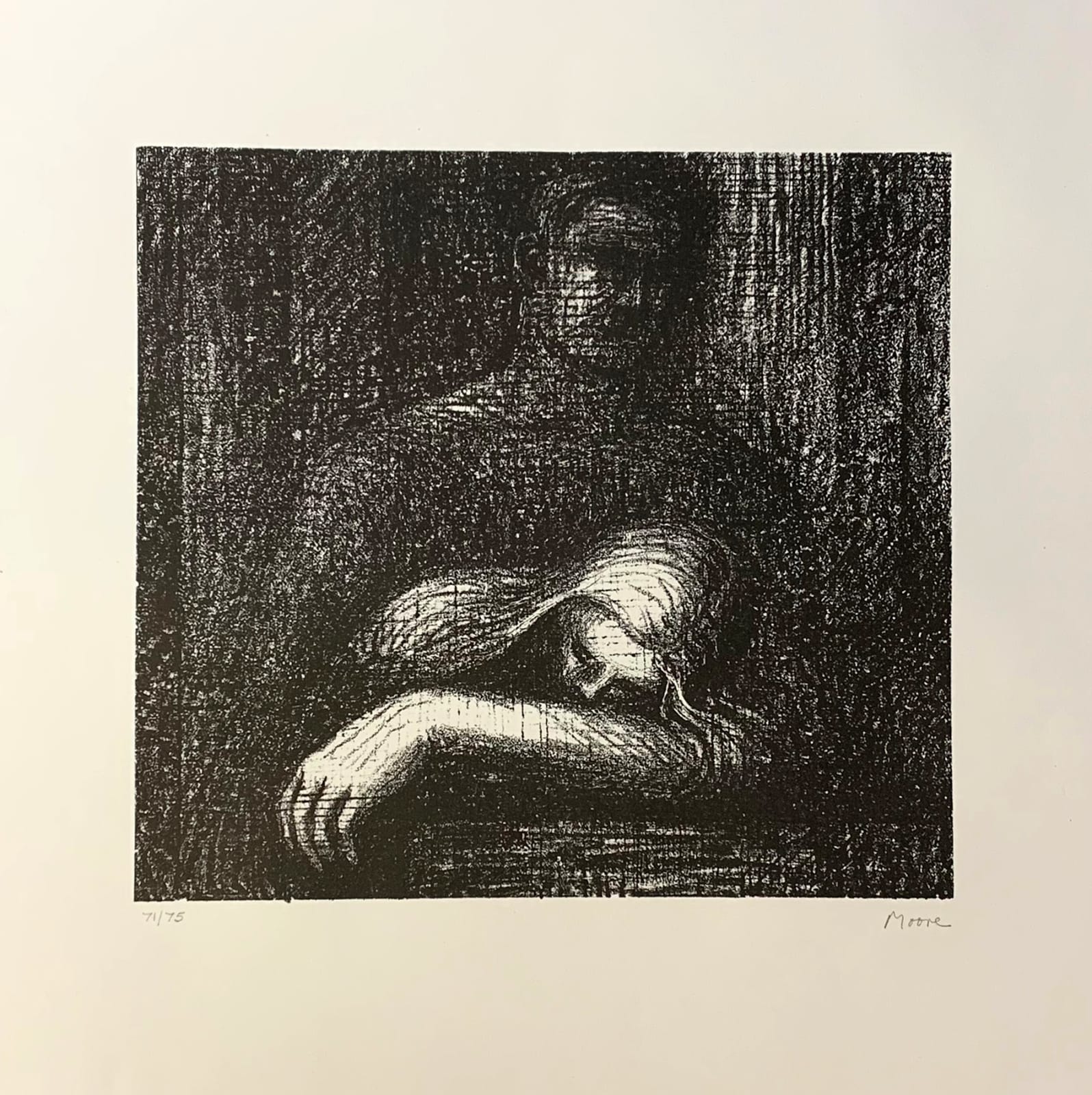Henry Moore British, 1898-1986
Lullaby Sleeping Head, 1973
Lithograph in colours on wove
Signed and numbered 71/75 in pencil
Signed and numbered 71/75 in pencil
64 x 50cm (unframed size)
67.5cm x 55cm (Framed)
67.5cm x 55cm (Framed)
71/75
Copyright The Artist
Lithograph Auden Poems./Moore Lithographs 1973 Signed Auden Poems./Moore Lithographs: Selections from Poems by Auden/Lithographs by Henry Moore/Petersburg Press [London 1974] Published as a book with an associated slipcase in two...
Lithograph
Auden Poems./Moore Lithographs
1973
Signed
Auden Poems./Moore Lithographs: Selections from Poems by Auden/Lithographs by Henry Moore/Petersburg Press [London 1974]
Published as a book with an associated slipcase in two editions: Edition A for Europe and Edition B for the Americas. All the books contain twenty-three unsigned lithographs, CGM 243 and 244 as endpapers and CGM 245-265 accompanying thirteen texts from the poems of W. H. Auden. The slipcases for each edition contain four signed lithographs unbound: Edition A has CGM 246, 248, 250 and 259; Edition B has CGM 253, 254, 260 and 262. Published separately was a portfolio formed by an unsigned and unnumbered lithograph CGM 266. It contains eighteen signed lithographs on large-margined paper unbound. Eleven of these are repeated from the book; seven, CGM 267-273, were made especially for the portfolio.
415 x 335mm: 54 unnumbered pages in 27 folded and uncut leaves of Hodgkinson paper, stitched and perfect bound, with CGM 243, 244 used as endpapers. The paper is watermarked with the initials of the author and the artist on the title and index pages. Edition A is bound in scarlet linen, Edition B in dark green linen, with the title blocked in black on the front.
The slipcase, similarly bound, and with internal paper flaps, contains the four lithographs printed on Hodgkinson paper watermarked with the initials of the press and the artist. Both the book and the slipcase are contained in a black linen-bound Solander box with the initials of the poet and artist designed by Henry Moore blocked in red on the front.
Often regarded as the father of modern British sculpture, Henry Moore’s large-scale bronze and marble sculptures can be found in public parks and plazas around the world. Working in various styles and mediums, Moore is perhaps best known for his highly abstract and interpretive renditions of the human figure, often portrayed in the reclining position. He was influenced by Classical, Pre-Columbian, and African art, and by Surrealism; his biomorphic style has been compared that of Salvador Dalí and Jean Arp. Moore was a longtime friend and colleague of fellow sculptor Barabara Hepworth, having met at the Leeds School of Art around 1919. He also admired the work of Constantin Brancusi, whose organic abstract style resonated with Moore’s belief that observation of nature is essential to artistic creation. Moore himself inspired many artists including his former studio assistants Anthony Caro and Richard Wentworth.
Auden Poems./Moore Lithographs
1973
Signed
Auden Poems./Moore Lithographs: Selections from Poems by Auden/Lithographs by Henry Moore/Petersburg Press [London 1974]
Published as a book with an associated slipcase in two editions: Edition A for Europe and Edition B for the Americas. All the books contain twenty-three unsigned lithographs, CGM 243 and 244 as endpapers and CGM 245-265 accompanying thirteen texts from the poems of W. H. Auden. The slipcases for each edition contain four signed lithographs unbound: Edition A has CGM 246, 248, 250 and 259; Edition B has CGM 253, 254, 260 and 262. Published separately was a portfolio formed by an unsigned and unnumbered lithograph CGM 266. It contains eighteen signed lithographs on large-margined paper unbound. Eleven of these are repeated from the book; seven, CGM 267-273, were made especially for the portfolio.
415 x 335mm: 54 unnumbered pages in 27 folded and uncut leaves of Hodgkinson paper, stitched and perfect bound, with CGM 243, 244 used as endpapers. The paper is watermarked with the initials of the author and the artist on the title and index pages. Edition A is bound in scarlet linen, Edition B in dark green linen, with the title blocked in black on the front.
The slipcase, similarly bound, and with internal paper flaps, contains the four lithographs printed on Hodgkinson paper watermarked with the initials of the press and the artist. Both the book and the slipcase are contained in a black linen-bound Solander box with the initials of the poet and artist designed by Henry Moore blocked in red on the front.
Often regarded as the father of modern British sculpture, Henry Moore’s large-scale bronze and marble sculptures can be found in public parks and plazas around the world. Working in various styles and mediums, Moore is perhaps best known for his highly abstract and interpretive renditions of the human figure, often portrayed in the reclining position. He was influenced by Classical, Pre-Columbian, and African art, and by Surrealism; his biomorphic style has been compared that of Salvador Dalí and Jean Arp. Moore was a longtime friend and colleague of fellow sculptor Barabara Hepworth, having met at the Leeds School of Art around 1919. He also admired the work of Constantin Brancusi, whose organic abstract style resonated with Moore’s belief that observation of nature is essential to artistic creation. Moore himself inspired many artists including his former studio assistants Anthony Caro and Richard Wentworth.




